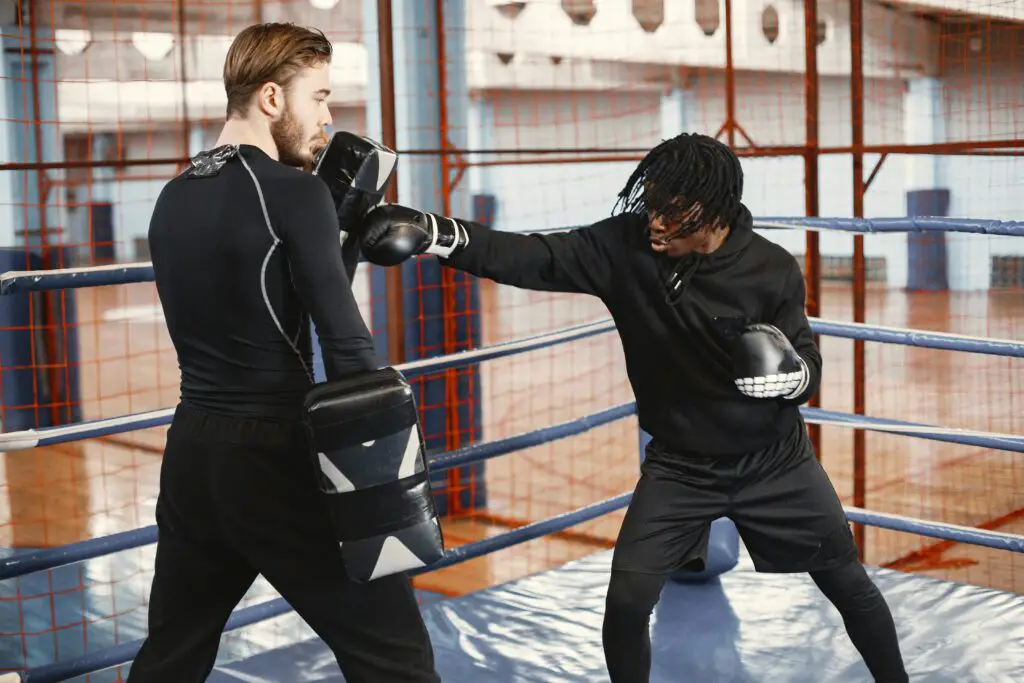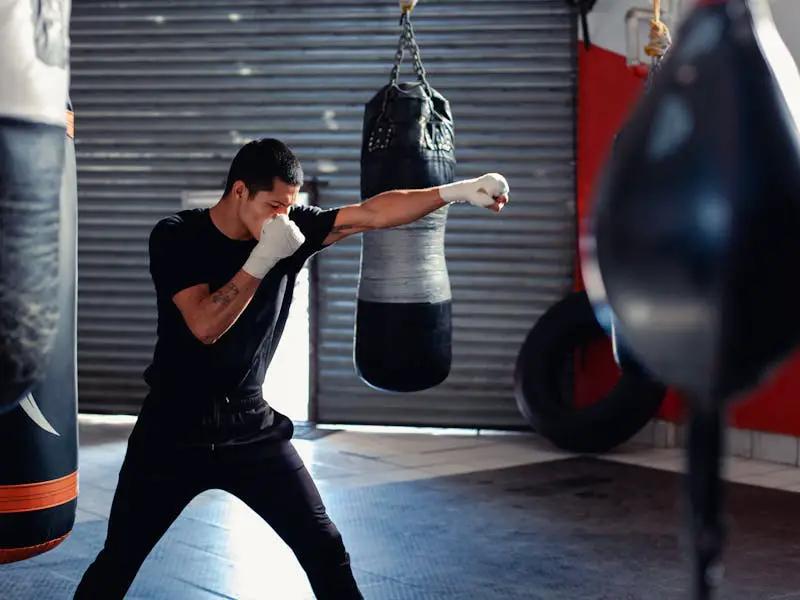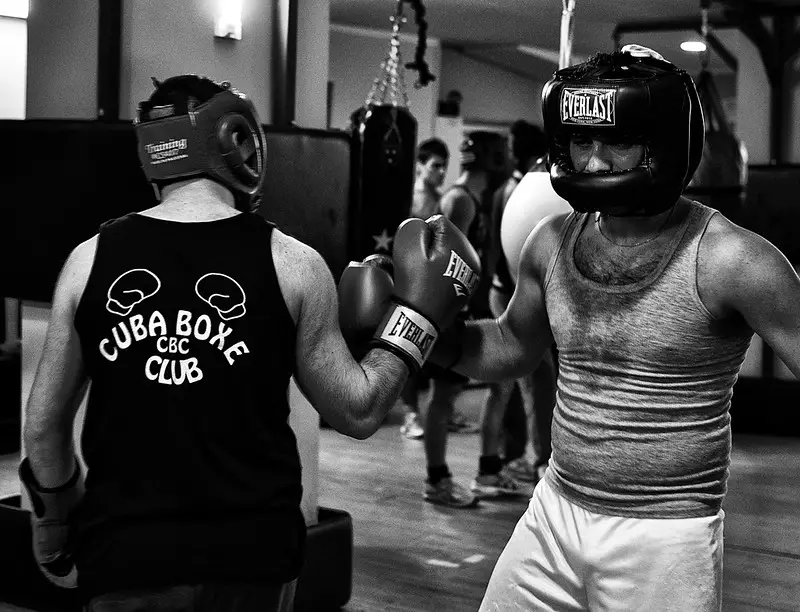According to statistics, boxing is the most popular combat sport and many people wonder how they can learn boxing quickly, or at least speed up the progress.
Luckily, there are many tips and workouts that enable a student to learn boxing fast. Most are related to your pragmatic approach to training and specific drills and workouts you can do in the gym and at home.
We will start with a general overview of how long it takes to learn boxing before diving deep into tips and workouts that help you learn it quickly, and avoid common mistakes that may slow down your progress.
How Long Does it Take to Learn Boxing?
On average, practitioners with no previous combat experience, average fitness level, and talent for sports need 6 months to learn the fundamentals, and around 15 months of total training time to prepare for a first amateur match, which is considered an advanced level.
Overall, the boxing concept is not too hard and every person can learn it in a reasonable time. While other martial arts require many years of practice to reach the same level, some over a decade, two years of consistent boxing training is enough to develop solid skills for most people.

But how you can learn it faster, you may ask?
Well, let’s explore specific drills, fitness workouts, and factors that speed up the process and help you learn boxing quickly.
How To Learn Boxing Quickly?
To learn boxing quickly, you need to focus on skill-specific drills to build a strong foundation, add strength and cardio workouts into your weekly training regiment, and be consistent. Here are some of the most important factors to consider if you want to boost your boxing progress.
Hit the gym 5 times a week
First thing first — hit the gym as much as you can. Learning boxing is all about hard work and repetition so the more time you spend on the mats, the faster you are going to progress. But as a beginner, you should pay close attention to how much rest you have. For the start, include 2 days off in a week.
Being consistent cuts the learning curve and prevents you from getting stuck or falling behind. By constantly drilling techniques and adopting new ones, you improve muscle memory, reaction time, and training instincts, which are, skill-wise, the most important if you want to learn boxing quickly.
Improve footwork with this workout
Learning the correct motion of a jab or hook is quite easy compared to how challenging it is to learn footwork and upper body movement.
Though it may look simple at first glance, boxing footwork requires agility, balance, coordination, and a lot of time to learn. Thus, focusing on mastering this segment right from the start will bring you to an advanced level much faster.
The good thing is, you don’t need expensive equipment for practice. Just a bit of space to move around. Some of the basic drills are:
- Cone Drills — set up cones in different patterns and practice moving around them
- Jump Rope — incorporate different footwork patterns, such as high knees, side-to-side movements, and double-unders.
- Agility Hurdles — Place hurdles at varying heights and distances. Practice stepping over them with quick and precise footwork, improving both agility and balance.
- Ladder Drills 1— Set up an agility ladder on the floor. If you don’t have a ladder, you can create one using tape. Start with quick steps by stepping with one foot into each square.
- Ladder drills 2 — do crossovers with one foot over the other as you move through the ladder. Last, do side-shuffles and Move laterally through the ladder by stepping both feet inside and outside of each square.
Shadowboxing Workout
Shadowboxing is an important boxing training method if you want to boost your progress because it allows you to memorize the motions and combinations, and improve muscle memory. You can do it at home, in the gym, or wherever you have enough space to move.

Most importantly, shadowboxing helps you improve the coordination needed to become better at mixing footwork with punches. This will boost your progress like nothing other, and elevate your game to an advanced level.
Here is a free shadowboxing workout you can do anywhere:
| Exercise | Duration | Break |
| Jump rope (warm-up) | 2-3 minutes | 30s |
| Dynamic stretches (arm circles, leg swings etc.) | 3 minutes | 30s |
| Jab | 2 minutes | 30s |
| Cross | 2 minutes | 30s |
| Jab-Cross Combo | 2 minutes | Catch and counter-drill |
| Jab-Cross-Hook combo | 2 minutes | 30s |
| Hook-Uppercut combo | 2 minutes | 30s |
| Freestyle shadowboxing | 3 minutes | 30s |
| Catch and counter drill | 2 minutes | 30s |
| Slip and roll drill | 2 minutes | 30s |
| Freestyle shadowboxing | 3 minutes | 30s |
Mirror Drills
Stand in front of the mirror and start practising movements, techniques, and combos while observing and refining your form. As a beginner, you should do it slowly, focusing on the correct motion, and posture, and performing in a relaxed and focused manner.
The mirror provides instant visual feedback, allowing you to identify any flaws or inconsistencies in your form. This includes your stance, hand positioning, body movement, etc. This self-awareness is crucial for faster progression in boxing as you don’t need to wait for the next training session and your instructor to correct you.
There are no specific mirror workouts. You just step in front of the mirror, and do regular drills. Here are some tips:
- Focus on specific aspects of your boxing technique, such as punches, defensive manoeuvres, and footwork.
- Pay attention to details like hand positioning, head movement, and weight distribution.
- Gradually increase the speed and complexity of the drills as you become more comfortable and proficient.
Boxing strength workout for faster progress
Improving strength is crucial for faster boxing learning, especially core strength which improves balance, power, and endurance. The following boxing routine focuses on compound movements to engage multiple muscle groups and combines both resistance and explosive exercises.
Consistency is key to progress. Combine this strength workout with your boxing training and maintain a well-balanced diet to support your overall fitness goals.
| Exercise | Sets x Reps | Rest Time |
|---|---|---|
| 1. Deadlifts | 4 x 6-8 | 90 seconds |
| 2. Squats | 3 x 8-10 | 60 seconds |
| 3. Bench Press | 4 x 6-8 | 90 seconds |
| 4. Pull-ups | 3 x Max reps | 60 seconds |
| 5. Box Jumps | 3 x 10-12 | 45 seconds |
| 6. Medicine Ball Slams | 3 x 15-20 | 45 seconds |
| 7. Plank Variations | 3 x 30-60 seconds each | 30 seconds |
Notes:
- Adjust the number of sets and reps based on your fitness level and training goals.
- Choose weights that challenge you while maintaining proper form.
- Perform this workout 2-3 times per week with at least one day of rest between sessions.
- Perform explosive movements with control, especially in exercises like medicine ball slams. Emphasize power and speed.
Boxing Cardio Workout For Faster Progression
Developing strong endurance is crucial because this enables you to go through high-intensity workouts without gassing out, and recover faster. So instead of gasping for air during the classes, you can entirely focus on technique and performance.
Here’s a boxing-inspired cardio workout that you can perform 2–3 times a week. Adjust the intensity based on your fitness level, and gradually increase the duration and intensity as you progress.
| Exercise | Duration | Intensity |
| Jump rope | 5 minutes | Moderate-High |
| Shadow Boxing | 3 minutes | High |
| Running in place | 3 minutes | High |
| Jumping Jacks | 45 seconds | |
| Box Jumps | 45 seconds | |
| Shadowboxing | 3 minutes | High |
| Jumping Jacks | 45 seconds | |
| Plank | 45 seconds | High |
| Bicycle Crunches | 45 seconds | High |
| Breaks: 30 seconds between exercises | ||
Set Realistic Goals and Be Humble
While enthusiasm is good, setting unrealistic expectations can lead to frustration. Even if you are the most dedicated student and athletically gifted, it takes a lot of hard work and time to become good at boxing. Focus on gradual progress and enjoy the learning process.
Setting unrealistic goals will make you feel stuck and frustrated the first time you face some challenges in training. No matter what you do, you will have that feeling of not progressing fast enough. Instead of focusing on actual techniques and work, you will get stuck inside the circle constantly looking for shortcuts and strategies to improve faster.
Stay humble, be open to feedback, and understand that improvement comes from continuous effort and willingness to learn.
Beginner Boxing Mistakes to Avoid
Like in any other sport, beginners are prone to making mistakes so being aware of some of the most common ones can help you to progress faster. Developing a proper boxing foundation without any major bad habits and tendencies can save you a lot of time because you don’t have to dedicate training sessions to correcting these issues.
Here are some of the most common beginner boxing mistakes to avoid:
- High Ego: A high ego can hinder learning. Stay humble, be open to feedback, and understand that improvement comes from continuous effort and willingness to learn.
- Having High Expectations: While enthusiasm is good, setting unrealistic expectations can lead to frustration. Focus on gradual progress and enjoy the learning process.
- Dropping Guard: Beginners should avoid dropping their guard, keeping their hands up to protect the face. A lowered guard leaves the face vulnerable to punches.
- Holding Breath: Beginners often hold their breath during exchanges, leading to fatigue. Remember to breathe consistently to sustain energy throughout the match.
- Skipping Warm-Up: Skipping warm-ups increases the risk of injury. Always warm up to prepare muscles and joints for the physical demands of boxing.
- Ignoring Defense: Neglecting defensive skills is a common mistake. Learn to slip, block, and parry punches to minimize damage and improve the overall defense.
- Not Using Angles: Standing directly in front of opponents makes it easier for them to hit back. Use angles to create openings and make it challenging for opponents to land punches.
Is Boxing Dangerous For Beginners?


